Different fish have different kinds of appearances. A few of them also have a horn-like protrusion. In this article, I will discuss some of the popular fishes that feature this kind of body structure.
Before you go through the details, here is a chart given below regarding the most interesting fact and behavior of those fish.
| Fish Name | Interesting Fact |
| Moorish Idol | They stay in pairs for life, and the adult males fight with each other. |
| Longhorn Cowfish | They are known to release a toxic substance when stressed, which can be lethal to other fish nearby. |
| Bluespine Unicorn Tang | They are able to change their coloration and pattern depending on their mood and environment. |
| Horned Blenny | It has a wide, blunt nose and a tentacle with many lobes right above each eye. |
| Unicorn Leatherjacket | They have a hard, bony plate covering their head that acts as a shield against predators. |
| Horned Sculpin | The male fish guards the eggs for weeks, fanning them with its pectoral fins to provide oxygen and protect them from predators. |
| Horn Shark | They are mostly venomous and have a distinctive “horn” on their dorsal fin, which they use to defend themselves from predators. |
| Axolotl | They are studied in the field of regenerative medicine since they can regenerate their limbs, spinal cords, hearts, and other organs. |
7 Popular Fish with Horn
Here are the details on 7 fish that have horns.
Moorish Idol

The Moorish Idol (Zanclus cornutus) is a marine fish that belongs to the family Zanclidae and the order Perciformes. This fish is easily recognizable by its striking black, white, and yellow coloration, giving it a regal appearance resembling Moorish kings’ royal attire.
The Moorish Idol is equipped with “oscelli,” which are protuberances over their eyes that give the appearance of horns. However, these curved structures are merely hardened portions of skin tissue to help stabilize and keep them upright in tumultuous seas.
The Moorish Idol’s diet is based on corals, sponges, tunicates, and other bottom-dwelling animals. This fish never stops searching for its next meal.
They are most commonly found in reef environments, such as coral reefs and rocky outcroppings, where they can graze on the algae found within these ecosystems.
This fish has a wide distribution throughout the Indo-Pacific region, from the eastern coast of Africa to the waters surrounding Hawaii and French Polynesia.
Moorish Idols are relatively timid and can be difficult to approach, often swimming away quickly if approached too closely. They typically lead solitary lives or form small groups consisting of a single breeding pair and their offspring.
Longhorn Cowfish
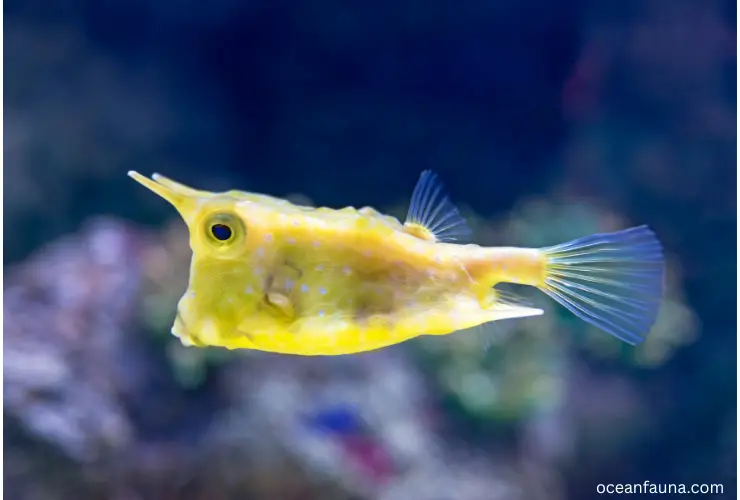
The scientific name of the Longhorn Cowfish is Lactoria cornuta. This fish belongs to the family Ostraciidae and the order Tetraodontiformes.
The Longhorn Cowfish has a unique appearance due to its box-shaped body and long horns protruding from its head. They grow up to 20 inches in length.
The omnivorous cowfish has a unique way of finding its food. It blows water jets into sand flats to uncover benthic algae, microorganisms, and foraminiferans buried in the sediment or hiding amongst sponges or polychaete worms. With this amazing adaptation, it is able to find sustenance from an otherwise hidden source.
Longhorn cowfishes can be found in a vast range of habitats, spanning from the Red Sea to East Africa, Indonesia, and Marquesas. Additionally, they are also abundant in southern Japan all the way north to the Ryukyu Islands, southward across Australia, and Lord Howe Island before reaching their easternmost point on Southern Africa’s Atlantic coast.
They are solitary creatures and are generally not aggressive towards other species. They are known to have unusual swimming behavior where they use their pectoral fins for swimming backward rather than forwards.
Bluespine Unicorn Tang

The Bluespine Unicorn Tang, or Naso unicornis, is a beautiful marine fish that belongs to the Acanthuridae family and the Perciformes order. This species of tang is characterized by its unique appearance, featuring a deep blue body with bright yellow markings and long trailing streamers on its caudal fin.
In the wild, Bluespine Unicorn Tangs are herbivorous and feed on a diet of algae and small invertebrates. They are typically found in coral reefs and lagoons, with a preference for shallow waters up to 180 meters deep. These fish are widely distributed in the Indo-Pacific region, specifically from Hawaii and the Marquesas Islands to the eastern coast of Africa.
Bluespine Unicorn Tangs are known to exhibit a social hierarchy in the wild, often gathering in groups with a dominant male at the top. They are also highly active swimmers and tend to be more active during the day.
Despite being a relatively common sight in the aquarium trade, the Bluespine Unicorn Tang is currently listed as a species of least concern in terms of conservation status. However, overfishing and habitat destruction remain potential threats to their survival. Therefore, ensuring sustainable harvesting practices and protecting the coral reefs where these fish live is important.
Horned Blenny
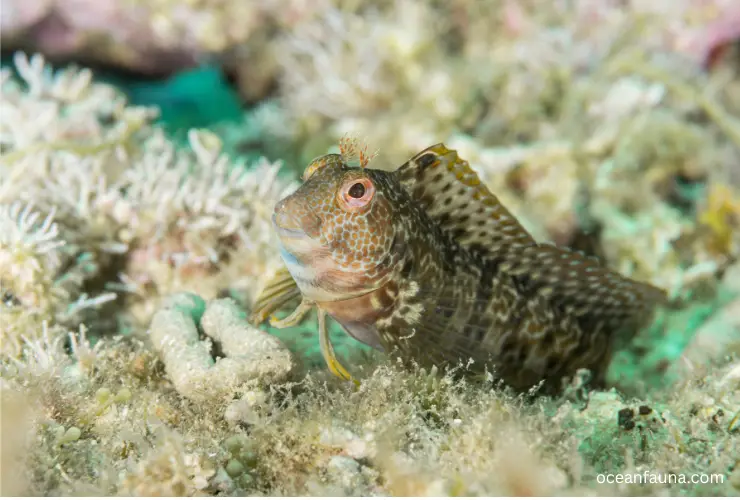
The Horned Blenny is a fascinating fish species with the scientific name of Parablennius intermedius. It belongs to the family of Blenniidae and the order of Perciformes. The Horned Blenny feeds on a diet consisting of small crustaceans, worms, and other small marine invertebrates.
Found in numerous locales, such as rocky shores, coral reefs, and seagrass beds, this fish is native to Australia’s eastern coast. Its habitat range extends from northern Queensland to the south of New South Wales.
The Horned Blenny is a small fish, growing to about 12 centimeters in length. Its distinct feature is the two pairs of tentacle-like antennae above its eyes, giving it the appearance of having horns.
In terms of behavior, the Horned Blenny is highly territorial and fiercely defends its territory against intruders. It is also an adept jumper, which helps it to evade predators. This species has a relatively short lifespan, living for about 3 to 5 years on average.
Unfortunately, the Horned Blenny faces various threats to its survival, such as habitat destruction, overfishing, and pollution. As a result, its population is currently declining, and it is considered a species of the least concern by the International Union for Conservation of Nature (IUCN).
Unicorn Leatherjacket
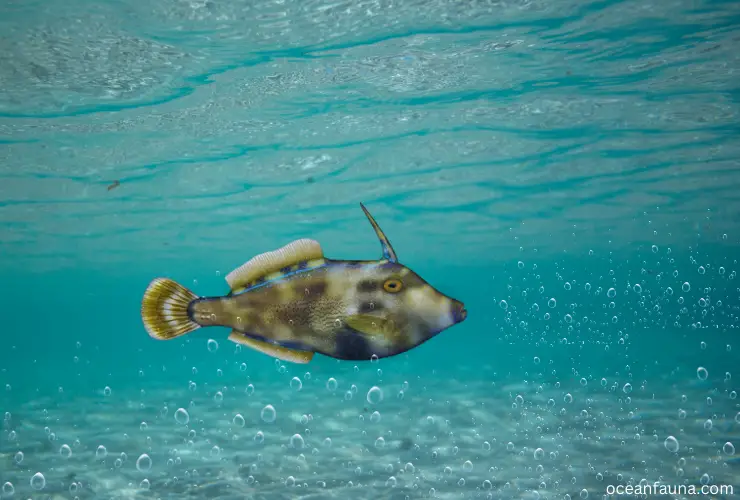
The Unicorn leatherjacket, also known by its scientific name Aluterus monoceros, belongs to the family Monacanthidae and the order Tetraodontiformes. This fish commonly feeds on bottom-dwelling invertebrates, such as crabs, clams, and snails.
Its preferred habitat is in warm, shallow coastal waters around coral reefs, seagrass beds, and rocky areas. The majestic Unicorn Leatherjacket can be found around the world. In Australia, it has been spotted as far southwest of Western Australia to the tropical north and down to New South Wales’s central coast.
Behaviorally, this fish can be quite shy and often hides in crevices or under rocks. It also uses its horn-like projection on its forehead to defend against predators.
The conservation status of the Unicorn leatherjacket is the least concern as it is a relatively common species in the wild.
Horned Sculpin
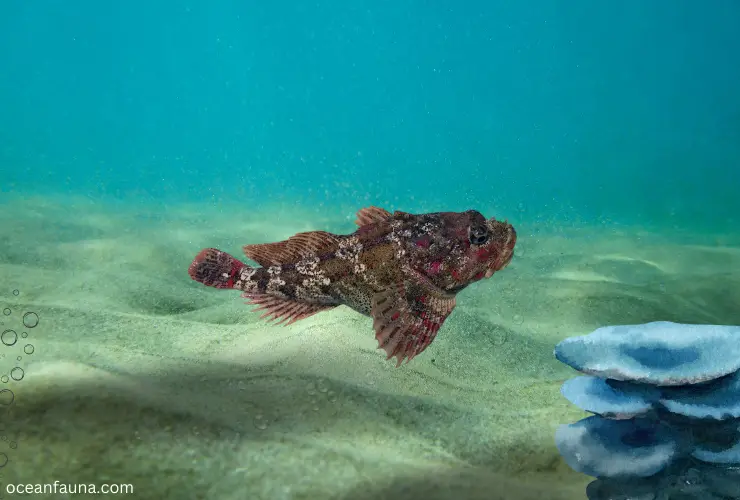
The Horned Sculpin is a species of fish that belongs to the Cottidae family and the Scorpaeniformes order. Its scientific name is Hemitripterus villosus.
This fish has 2 subgroups – one is twohorn sculpin, and another one is fourhorn sculpin. The difference is just in their appearance, their two horns or four horns. Found mainly along the coastlines of Finland and in its lake district’s depths, these fish are ubiquitous throughout the country.
The Horned Sculpin is a carnivorous predator that feeds on a wide range of small marine creatures, such as crustaceans, mollusks, and small fishes. They also feed on insect larvae, fish eggs, and copepods. However, these fish are also adaptable to their environment and therefore eat whatever is available.
The Horned Sculpin is known for its aggressive behavior and territoriality. They will often attack other fish, especially when defending their territory or young. They can also display a great deal of intelligence in their hunt for prey.
Horn Shark
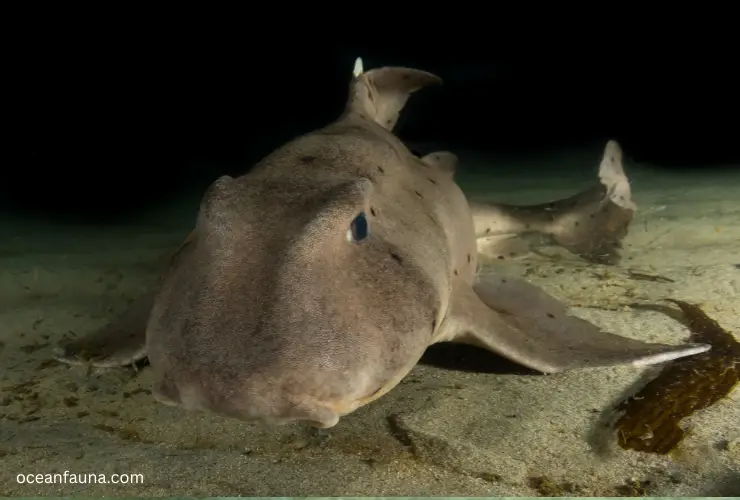
The Horn Shark, or Heterodontus francisci, is a species of bullhead shark and belongs to the Heterodontidae family. It is an order of sharks that includes about 9 species. These sharks are named after their unique heterodont dentition, which is characterized by different types of teeth in each jaw.
Horn Sharks are carnivorous and feed on crustaceans, small fish, and octopuses. They are slow-moving, bottom-dwelling sharks and are most commonly found in rocky and coral reefs in the Eastern Pacific, ranging from the Gulf of California to Southern California.
These sharks can grow up to 3-4 feet long and have a distinct coloration. They are typically grey or brown with spots or bluish-white stripes on the body, fins, and head. The Horn Shark is a nocturnal hunter, spending most of the day hidden in caverns or under rocks, venturing out at night to forage for food.
The Horn Shark is not considered very dangerous to humans, as it has a small mouth and is not aggressive. However, if provoked or stepped on, they will bite as a form of defense. Also, these sharks are mostly venomous (Port Jackson Shark) but not deadly to humans.
Axolotl
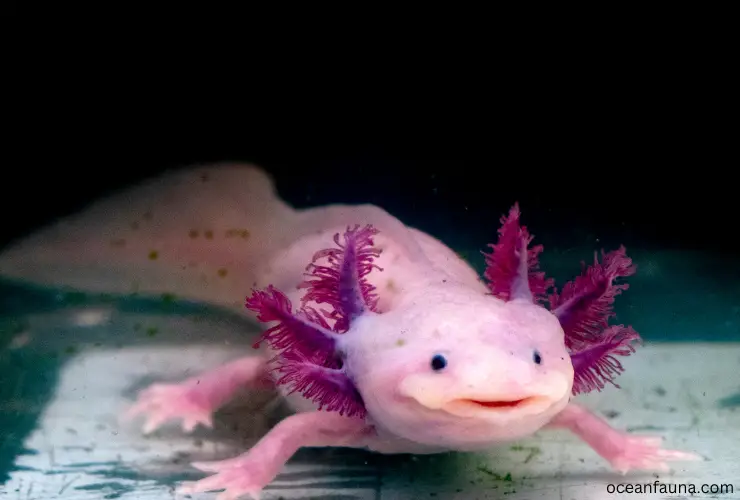
The axolotl (Ambystoma mexicanum) is a salamander species belonging to the family Ambystomatidae and order Caudata. This fascinating fish is also commonly known as the Mexican salamander or the Mexican walking fish.
Adorned with a set of three striking, feathery horns on each side of their heads, the axolotl proudly flaunts their frilly gills in full view. Native to the canals and lake systems of Xochimilco and Chalco in the Basin of Mexico, the axolotl prefers to inhabit freshwater environments where it can feed on small invertebrates, amphibians, and fish.
Axolotls are distinguishable from other amphibians by their unique ability to regenerate limbs, the spinal cord, the heart, and other organs. They also differ from most other salamanders because they retain their larval features throughout their adult lives, including their external gills, which offer a striking appearance.
Interestingly, axolotls can undergo metamorphosis, but only under specific conditions, and usually, individuals that have undergone metamorphosis are sterile.
The axolotl is considered a critically endangered species due to the impact of human activities, particularly pollution, the introduction of invasive species, and the decline in the quality and availability of their habitat. Efforts are underway to conserve this species and its habitat, including breeding programs and restoration projects.
Conclusion
Now you know about the 7 living fish with horns. Although all are not the same, they have some similarities, like their diet, slow-moving behavior, and territoriality.
The horns have been used for different purposes like defense or attack. These horns are sometimes venomous and can be dangerous to humans if provoked.
If you have any questions about these fish, just let me know.


1 thought on “7 Popular Fish With Horn: A Compact Explanation”